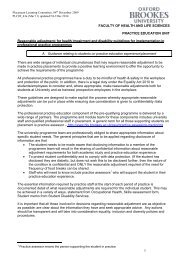February 2013 - Faculty of Health and Life Sciences - Oxford ...
February 2013 - Faculty of Health and Life Sciences - Oxford ...
February 2013 - Faculty of Health and Life Sciences - Oxford ...
- No tags were found...
Create successful ePaper yourself
Turn your PDF publications into a flip-book with our unique Google optimized e-Paper software.
Tiger Conservation into the21st CenturyOpen Lecture SeriesMain Lecture Theatre27 <strong>February</strong> 6.00pmPr<strong>of</strong>essor Stewart Thompson’sinaugural Pr<strong>of</strong>essorial LectureIt is not easy to see a tiger – even if you arelooking in the right place! At the start <strong>of</strong>the 20th century there were an estimated100,000 worldwide. Today, although theactual number is subject to disagreementbetween tiger range Governments, tigerbiologists <strong>and</strong> Forest <strong>of</strong>ficials, there isconsensus that this number is somewherebetween 3 - 5,000.Some tiger biologists prefer to think <strong>of</strong>them as having sub-species – <strong>of</strong> the ninesub-species they recognise, three, arealready gone, with a fourth functionallyextinct. Others believe there are only tw<strong>of</strong>orms – the ‘nominate’ (typical) <strong>and</strong> the‘Sunda Isl<strong>and</strong>s’ (Indonesian) tiger. Whilstthis lumping versus splitting debate hassome conservation implications, the factremains that whichever way we look at it –tigers are in big trouble.Today wildlife conservation has movedaway from a species-centric to al<strong>and</strong>scape or ecosystem approach.Modern tiger conservation centres aroundthe identification, maintenance <strong>and</strong>protection <strong>of</strong> “Tiger Conservation Units”or “Critical Tiger Habitat”. One recentpiece <strong>of</strong> research identified 160 distinctl<strong>and</strong>scapes where tigers are found. Ofthese 60% were calculated to be unviable,with the vast majority <strong>of</strong> the 160 havingfewer than 25 breeding adults. Perhapsthe most sobering aspect <strong>of</strong> this workJ. Patrick Fischerwas the conclusion that as few as six tigerl<strong>and</strong>scapes exist that have more thanthe minimum number <strong>of</strong> breeding adultspopulation biologists consider necessaryto ensure a viable population in perpetuity.At face value tigers have scores <strong>of</strong> friends.There are numerous NGO’s pouringmillions <strong>of</strong> pounds into their conservationannually. Add to this the multi-million dollartourism industry that surrounds them <strong>and</strong>clearly they are <strong>of</strong> major economic <strong>and</strong>social importance. The recent decisionto close all Indian tiger reserves to tourismwas met with outcry from the tens <strong>of</strong>thous<strong>and</strong>s <strong>of</strong> individuals who rely, directlyor indirectly, upon them for their livelihood.The tiger tourism industry rallied round <strong>and</strong>the decision was reversed, but for howlong? For many observers the removal<strong>of</strong> tiger tourism will be their death knell.Therefore developing an underst<strong>and</strong>ing <strong>of</strong>tourism impacts to both tigers <strong>and</strong> humansis vital if tigers are to have a chance <strong>of</strong>survival into the 21st century <strong>and</strong> beyond.Conservation biologists are firmly <strong>of</strong> thebelief that we are at a cross-roads forthe world’s tigers. Current protectionmechanisms are not working <strong>and</strong> a newapproach to tiger conservation must bearrived at <strong>and</strong> quickly! Without this newapproach the price will be the loss <strong>of</strong>the tiger <strong>and</strong> the admission that we didnot have the ability to save the planet’smost iconic species. As part <strong>of</strong> theOpen Lecture series Stewart Thompsonwill therefore explore a number <strong>of</strong> keyquestions linked to how best we canprotect <strong>and</strong> exp<strong>and</strong> their remainingpopulations <strong>and</strong> asks what chance dotigers have in their remaining strongholds?Forthcoming EventsBrookes Science Bazaar, 16 March <strong>2013</strong>:https://shsc-int.brookes.ac.uk/blogs/outreach/?p=157deadline for online activity registration is 7 January <strong>2013</strong>.Attention: We only called it ‘Science Bazaar’ because ‘Evidence based Research Bazaar’ isn’t catchy.ALL researchers from FHLS are invited to run an activity based on their research field.Darwin, Sex <strong>and</strong> Sexual Selection, 27 March <strong>2013</strong> at 6pm:The <strong>Faculty</strong> Annual Research Lecture by Pr<strong>of</strong>essor Tim BirkheadPlaces can be booked at www.brookes.ac.uk/about/eventsAmazing Acts Festival, 7-10 May <strong>2013</strong>:https://shsc-int.brookes.ac.uk/blogs/outreach/?p=176registering expression <strong>of</strong> interest now.Please have a look <strong>and</strong> if you have any questions or would like to discuss ideas, drop Anne Osterriederan email.Statslink <strong>and</strong> Mathslink Short Courses for ResearchersStatistical Methods for Data Analysis 2, 11 <strong>and</strong> 12 June <strong>2013</strong>10 Research News
















